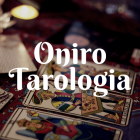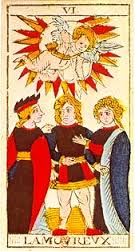Lovers Tarot Card and Jung
What is the meaning of the Lovers Tarot card in a Jungian persepctive? What would Jung say about the Tarot Lovers?
I report here a recent article on the Lovers Tarot card and Jung. I’ve written this article for CEPEIDE, Magazine of Intersubjective Evolutionary Psychology on invitation of Giuseppe Fojeni, psychologist and psychotherapist.
Meaning of the Lover Tarot Card
The Tarot cards are visual representations with a high symbolic and archetypal content. They are visual aids that can therefore help us to look into the depths of the unconscious. Tarot and manifestations of the unconscious (for example dreams) speak the same language.
I want to give an account of this article, referring to the Arcanum VI of the Tarot, The Lovers. Let’s start by describing what we see. The protagonist, at the center of the scene, is a young man. We can deduce it from the flowing and wild hair and the multicolored dress. In psychological terms this means indeterminacy but also multiple potentials and viable paths.
Being the protagonist of the scene, it is the character with which the observer is invited to identify himself. This is an element of novelty by analyzing the sequence of Tarot that precede this arcanum. From the “Fool” to the “Pope”, we are in the presence of gigantic figures, which fill the entire surface of the card. They are figures sitting on a throne, thus making it hard for the observer to identify himself with the protagonist of the card. They represent the parental figures, custodians of an authoritative force. Those are powerful archetypal images, of a semi-divine nature. Faced with these characters our Ego is subjugated, unable to make autonomous choices.
The Lovers Tarot card as the young “Ego”
With the Lovers Tarot Card, the action is brought back to a very earthly plane, to a human dimension. The theme of choice and responsibility arises. The young man is standing at a crossroad, he has two women in front of him. There are two possible options: it is the young “Ego” who begins to develop and make autonomous choices in the field of consciousness, freeing himself from the power of parental archetypes.
The choice, I underline it, takes place in the field of consciousness. What the young person sees, feels and perceives in the field of action that is known to him. But by widening the picture, we discover that the scene takes place only partially on the earthly and tangible plane of consciousness. At the top, behind him (therefore a force acting on the unconscious dimension), a numinous entity is operating. It is a Cupid who shoots an arrow. This “heavenly” intervention will in fact condition the destiny and the choice of the protagonist, only apparently conscious.
The young man seems uncertain about what to do. From the language of his body, however, one can guess what his choice will be. The protagonist expresses a movement towards the woman on the right, After all, the hand of the young girl converges on the same objective of the arrow shot by Cupid, towards his heart, then his emotional center. On the other hand, his gaze (hence his intellectual faculties, his thinking-related functions) is addressed to the woman on the left. In fact, we note that there is no eye contact with the woman on the right. There is no relation with her on an intellectual level, but only on that of feeling. It is a very interesting way to depict the contrast between the functions of thinking and feeling.
Jungian symbolism of the Lovers
What do the two women represent? The woman on the left is older and seems to grab the protagonist by the shoulder, pointing to the ground. She seems to invite the young man to keep his feet on the ground, anchored to his roots. It is a compensation with respect to the upward pressure caused by the winged Cupid. We could therefore see in the woman of the left a representation of the maternal archetype. It is the generative nature, the collective unconscious to which everyone is rooted.
The woman on the right can instead represent the Anima archetype, that is the personal unconscious of the protagonist, his own feminine principle. According to a Jungian perspective, we could then read the Lovers Tarot Card as the Ego which, although eternally rooted in the collective unconscious, is going after his own Anima, re-establishing a union with his feminine principle.
It is a search that will last a lifetime, mysteriously guided by the numinous entity of the Self and its arrows. Those arrows will force the young Ego, willingly or unwillingly, to follow his personal destiny.


1 thoughts